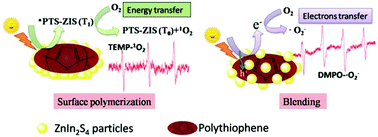当前位置:
X-MOL 学术
›
Catal. Sci. Technol.
›
论文详情
Our official English website, www.x-mol.net, welcomes your
feedback! (Note: you will need to create a separate account there.)
Insights into the generation of reactive oxygen species (ROS) over polythiophene/ZnIn2S4 based on different modification processing†
Catalysis Science & Technology ( IF 4.4 ) Pub Date : 2018-03-19 00:00:00 , DOI: 10.1039/c8cy00303c Bo Gao 1, 2, 3, 4, 5 , Sidra Iftekhar 6, 7, 8, 9, 10 , Varsha Srivastava 6, 7, 8, 9, 10 , Bhairavi Doshi 6, 7, 8, 9, 10 , Mika Sillanpää 6, 7, 8, 9, 10
Catalysis Science & Technology ( IF 4.4 ) Pub Date : 2018-03-19 00:00:00 , DOI: 10.1039/c8cy00303c Bo Gao 1, 2, 3, 4, 5 , Sidra Iftekhar 6, 7, 8, 9, 10 , Varsha Srivastava 6, 7, 8, 9, 10 , Bhairavi Doshi 6, 7, 8, 9, 10 , Mika Sillanpää 6, 7, 8, 9, 10
Affiliation

|
The performance of a polythiophene-modified ZnIn2S4 hybrid photocatalyst was associated with the processing methods. We reported the influence of different modification methods (blending versus surface polymerization) on photogenerated reactive oxygen species (ROS) and photocatalytic degradation of tetracycline. The photocatalytic degradation of tetracycline was enhanced with polythiophene modification either by blending or by surface chemical polymerization, and 51% or 54% NPOC (non-purgeable organic carbon) removal was achieved, respectively, in comparison with 36% for ZnIn2S4. Nanosized particles in the range of 10–20 nm were observed in pure ZnIn2S4 and the blended sample (PTh-ZIS) via an ethanol-thermal method, resulting in a high surface area of 188 m2 g−1 and 209 m2 g−1, respectively. The optical property of ZnIn2S4 still dominated the blended samples so that superoxide radical (˙O2−) was generated from ZnIn2S4 through electron transfer. For surface polymerization samples, transmission electron microscopy (TEM) clearly showed that ZnIn2S4 particles were covered by a thin polythiophene film, which can act as a photosensitizer promoting the generation of singlet oxygen (1O2) through energy transfer. Overall, our work revealed important processing guidelines together with ROS detection for the conductive polymer-modified photocatalyst.
中文翻译:

基于不同的修饰工艺 ,了解聚噻吩/ ZnIn 2 S 4上活性氧物质(ROS)的产生情况†
聚噻吩改性的ZnIn 2 S 4杂化光催化剂的性能与加工方法有关。我们报道了不同的改性方法(共混与表面聚合)对光生活性氧(ROS)和四环素光催化降解的影响。四环素的光催化降解通过聚噻吩改性(通过共混或通过表面化学聚合)得到增强,与ZnIn 2 S 4的36%相比,分别去除了51%或54%的NPOC(不可吹扫的有机碳)。在纯ZnIn 2 S 4中观察到了10–20 nm范围内的纳米级颗粒以及通过乙醇热法的混合样品(PTh-ZIS),分别产生了188 m 2 g -1和209 m 2 g -1的高表面积。日宁的光学特性2小号4使得超氧自由基(O仍然占主导地位的混合样品2 -从日宁产生)2小号4通过电子转移。对于表面聚合样品,透射电子显微镜(TEM)清楚地表明ZnIn 2 S 4颗粒被聚噻吩薄膜覆盖,该薄膜可以用作光敏剂,通过能量转移促进单线态氧(1 O 2)的产生。总体而言,我们的工作揭示了重要的加工准则以及用于导电聚合物改性的光催化剂的ROS检测。
更新日期:2018-03-19
中文翻译:

基于不同的修饰工艺 ,了解聚噻吩/ ZnIn 2 S 4上活性氧物质(ROS)的产生情况†
聚噻吩改性的ZnIn 2 S 4杂化光催化剂的性能与加工方法有关。我们报道了不同的改性方法(共混与表面聚合)对光生活性氧(ROS)和四环素光催化降解的影响。四环素的光催化降解通过聚噻吩改性(通过共混或通过表面化学聚合)得到增强,与ZnIn 2 S 4的36%相比,分别去除了51%或54%的NPOC(不可吹扫的有机碳)。在纯ZnIn 2 S 4中观察到了10–20 nm范围内的纳米级颗粒以及通过乙醇热法的混合样品(PTh-ZIS),分别产生了188 m 2 g -1和209 m 2 g -1的高表面积。日宁的光学特性2小号4使得超氧自由基(O仍然占主导地位的混合样品2 -从日宁产生)2小号4通过电子转移。对于表面聚合样品,透射电子显微镜(TEM)清楚地表明ZnIn 2 S 4颗粒被聚噻吩薄膜覆盖,该薄膜可以用作光敏剂,通过能量转移促进单线态氧(1 O 2)的产生。总体而言,我们的工作揭示了重要的加工准则以及用于导电聚合物改性的光催化剂的ROS检测。











































 京公网安备 11010802027423号
京公网安备 11010802027423号